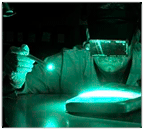RFID in the Crime Lab: Using Auto-ID Technology to Track Criminal Evidence
by David C. Wyld, Southeastern Louisiana University
 There is no setting in the private or public sectors where a verifiable “chain of custody” is more essential – or more lacking – than the handling of evidence in criminal cases. In the United States, the legal system is dependent on the proper handling of all forms of physical evidence – from bodily fluids to cigarette butts to guns, knives and weapons of all sorts.
There is no setting in the private or public sectors where a verifiable “chain of custody” is more essential – or more lacking – than the handling of evidence in criminal cases. In the United States, the legal system is dependent on the proper handling of all forms of physical evidence – from bodily fluids to cigarette butts to guns, knives and weapons of all sorts.
Such evidence must be managed from its retrieval from the actual crime scene through storage (with handling by police investigators and both criminal prosecutors and defense attorneys) until the items of evidence are presented in court if – and when – cases actually go to trial – often times several years after the crime has occurred.
Thus, all law enforcement agencies – from local police and county sheriffs to and state and federal agencies – must be concerned with the “chain of custody” as they collect, register, store, ship and track the evidence in their possession for criminal cases. Ensuring that this very unusual supply chain – from origin in the field to use in the courtroom – is secure and verifiable has been categorized as one of the fundamental responsibilities of law enforcement agencies, one that underpins the effectiveness and accuracy of the criminal justice system.
However, most law enforcement agencies have evidence handling systems that remain largely unchanged from the 1950s. Most police departments simply have an evidence room (and for agencies in larger cities, this “room” may be a whole warehouse). There, evidence is stored for possible use in investigating and prosecuting criminal cases – often needing to be retained for years and handled by numerous hands in that time period.
These critical items are managed most often using paper-based systems, often without computerized inventorying and logging of evidence being checked in and out of the area. Not only are such manual evidence tracking systems time and labor intensive for police officers, they are prone both to inaccuracy and errors and to intentional misuse and abuse.
Criminal cases have had to be dismissed before going to trial or lost in the courtroom due to critical items of evidence simply being lost in the evidence room. Likewise, all across the country, cases have been brought against police officers for internal theft of valuable items – such as narcotics, guns, jewelry, electronics, and cash – stolen from evidence storage facilities.
Also, when agencies do conduct manual inventories of their evidence rooms, they are often surprised at the items that are not found – and confounded by some that are there. Some have dated back to cases that are decades old – items that should have long ago been returned to their rightful owner, or else, sold at auction, donated to charity, or simply disposed of after the case they were being held for had been adjudicated.
And surprisingly, there has been very little use of “new” technology in this area, with many agencies just now moving to hybrid systems (with computerized databases fed by manual record keeping) and very few bar code based evidence tracking systems on the market today.
RFID is on the Case
This sounds like a job for RFID, and today, there are several American firms that are looking to automatic identification technology as a way to reinvent the evidence management and tracking process. With RFID-based systems, they can offer law enforcement agencies, for really the first time, the prospect of having an electronic, verifiable chain of custody for evidentiary items in criminal cases – vital for conducting criminal investigations and prosecutions in the CSI-influenced world of American justice.
Such systems also hold forward the prospect of not just more effective evidence management internally within a single agency, but new possibilities for bringing visibility and connections to what have been heretofore the ultimate information silos – with each separate police department having its own, often non-computerized and accuracy-challenged evidence tracking system in place.
The leading players in this market to date include:
- Intelligentz, based in Austin, Texas, offering the Clues and Blutrax tracking systems (http://www.intelligentz.net)
- Lockwood Technology, based in Manchester, New Hampshire, (http://www.lockwoodtechnology.com), offering the QuickTrac system
- Sysgen, based in Melville, New York, offering the eTraxx system (http://www.sysgen.com).
Each markets variations on the same idea – RFID-based tracking of evidence from the point of collection in the field to the evidence storage facility and tracking all movements of such articles throughout their life span as items involved in active criminal cases. Passive labels or tags are can be applied at the crime scene, with location and date/time data being recorded through the use of either RFID readers or PDAs equipped with GPS. When the items are brought in from the field, they are held in a secure space with fixed RFID readers monitoring the doorways of the evidence storage room or warehouse – or even subspaces within them.
Hand-held readers can then be used to locate items within the evidence facility. The systems work with either proprietary inventory management systems and/or standard database software to provide constant inventory reporting capabilities, along with the ability to create an electronic chain of custody report for individual pieces of evidence to know “where” and “when” items were viewed or moved in a criminal investigation. As smart cards and electronic IDs are integrated into police agencies, the “who” actually handled the item can be automatically recorded without any human intervention as well.
All three firm’s systems – while relatively very new – are gaining traction in the law enforcement marketplace, with each having multiple agencies using their respective tracking systems, and each having its own unique features. For instance, the handheld reader used in the QuickTrac system not only tags the evidence on-site, but captures a digital photo of the item in the field.
Intelligentz’s Clues system includes the option of using active tags to track higher value – whether monetary or case-critical in nature – in the evidence storage facility. As such, the system can send alerts to supervisors if such high-security evidence is moved without authorization – even within the room or warehouse.
What does RFID evidence tracking mean for the future of law enforcement and criminal justice – and the RFID industry? Certainly, the timing of the convergence between the technological leap forward that RFID represents and the rising expectations in criminal justice – due to the CSI affect – will propel many law enforcement agencies to have to seriously examine their evidence tracking processes.
This should bode well for these early entrant RFID integrators that are pioneering auto-ID technology in the law enforcement area. However, it will likely mean that we could see bigger RFID players also enter the law enforcement vertical as a new growth market for their own hardware, software and services or through market consolidation. If there is movement toward standardizing RFID–based evidence management protocols and further sharing of information between law enforcement agencies’ databases, this could usher in nothing less than a new era in policing.
Michael Lucas, the founder and CEO of Intelligentz, recently described his vision for how such standardization and interlinking of law enforcement evidence management systems might work: “Having multiple agencies using a unified chain-of-custody application would create an unprecedented level of crime scene visibility. Lucas emphasized his point by illustrating that: “A size 5 glove found at a crime scene in one city might match the same type of glove found in another state. Without using such a system, there’s no easy way to link those pieces of evidence.”
So, over the next decade, RFID will likely play an increasingly vital role in helping to piece the puzzle together to help solve crimes by improving evidence collection, management, and tracking capabilities – creating new opportunities for the RFID industry in the process – and not just in the U.S, but around the world.
Wyld is a professor at Southeastern Louisiana University and director of the strategic e-commerce/e-Government initiative in the department of management. He can be reached dwyld@selu.edu.




